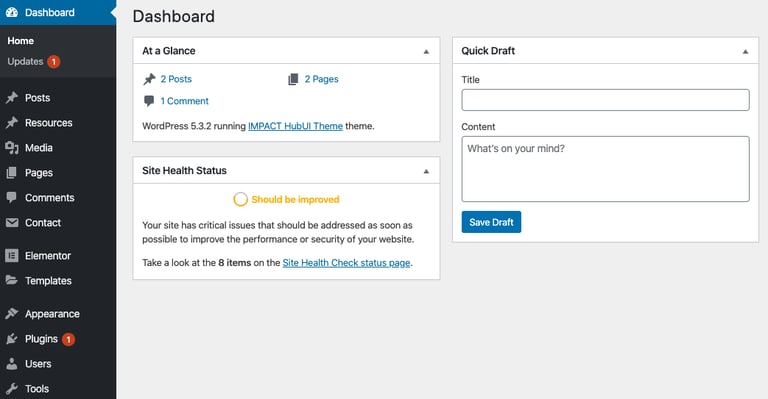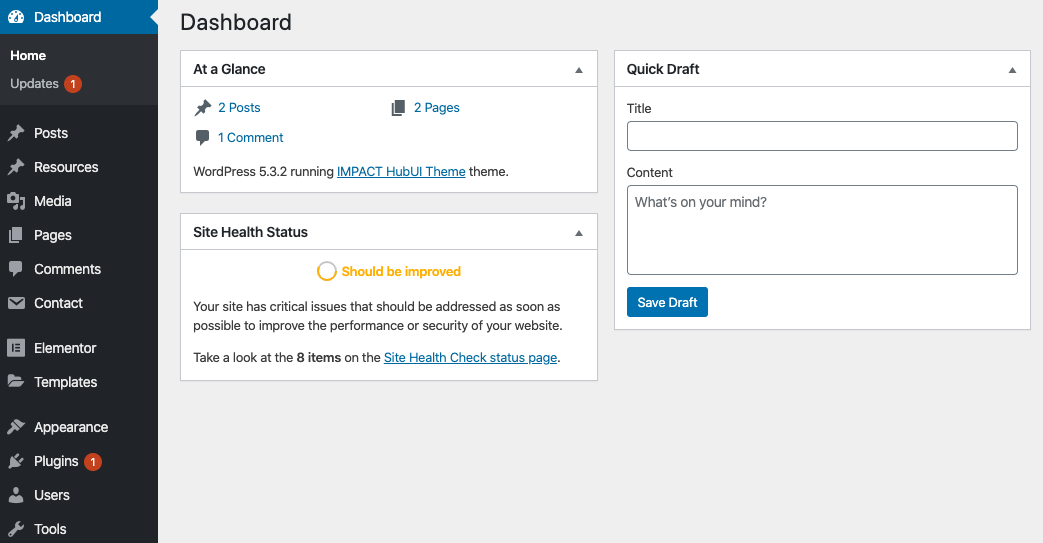Topics:
Web DesignSubscribe now and get the latest podcast releases delivered straight to your inbox.
3 crucial steps to take when your WordPress theme is no longer supported

Mar 13, 2020

A theme on WordPress is the foundation on which most of a website’s visual layer — the part that your customers see when they land on any page of your site — lives.
The theme usually controls your site’s layout, design, and its functionality.
As such, when a new site is being developed, a great deal of time is spent either custom developing or choosing the theme that will dictate the experience used to delight your customers.
I say usually because that’s not always the case.
Third-party or custom plugins are also available (and quite common) to override, enhance, or augment your theme’s functionality.
Just like everything else software related, it’s important to continuously update your theme so it remains secure and functioning properly.
A super outdated theme is the #1 way to get hacked not to mention you might just wake up tomorrow and find your site completely down so you need to make sure that your theme is always supported, or “maintained” by one of its creators.
Most themes, whether commercial or open-source — meaning free to use and/or distribute — are supported, updated, or patched by their creators indefinitely.
There’s a large open-source community that prides itself on providing software “for everyone” and they are, typically, very passionate about helping other developers improve their software -- forever.
GitHub, a hugely popular developer site and resource, exists for this very reason.
Now, this sounds like a big commitment right?
That’s because it totally is.
All this said, for those creators who are either profit-based and commercially-backed or open-source community supported, it’s unusual for a project to be completely abandoned.
Still, from time to time, some projects are abandoned and become unsupported because they just become too much work for their original creator(s).
Too many user questions, too many bugs to fix, or too many children over the years (I saw this as a reason once) — it’s just not something that they’re passionate about anymore and they openly abandon the project because they never figured out how to scale their support efforts.
What do you do if you find yourself in this situation?
Let’s start from the top.
How to know if your theme is no longer supported
When WordPress has any pending updates — for plugins, themes, or for the core software — a red circle with white number representing the amount of updates available is shown on the dashboard’s interface.

It is a best practice, and my professional recommendation, that you address these as soon as possible since these updates can contain vital security patches along with bug fixes that will keep your site functioning as securely and efficiently as possible.
If you manage your own website, use a popular theme, and are seeing regular updates come across, then chances are there’s nothing you need to do other than sign into your WordPress Dashboard regularly to look for these notifications and address them.
But, if you haven’t seen an update in a while and are curious if your theme is still being supported, check the place where you procured it.
That may be the free directory provided by WordPress, a development agency — here at IMPACT, for example, we develop custom WordPress themes and plugins for our clients — or it may be a place like the Envato Market.
To find the name of your theme, you’d navigate to the Appearance menu item on your WordPress Dashboard’s left sidebar and look for the active theme (usually the first one) that comes up when you land on the next page.
Then you can run a search, either on Google, or one of the other sites mentioned above to see if you can find the place where it was procured.
Once you’re there, you’ll want to look for a link that says either author or creator’s website and follow that.
“The operation of this website has ended. Themes are no longer supported and maintained.”
If you encounter a message similar to the one above on the theme or theme creator’s website, then that means your theme is no longer being supported, and depending on how long ago that was, your theme may already be posing a security threat for your site and your customers.
What do you do? The theme you stressed over buying, the one you invested time, money, and energy into customizing to your brand and controls the look-and-feel of your entire site is now unsupported and vulnerable to changes that can’t be controlled.
Following are the steps you need to take to get your theme up-to-date and stay that way.
1. Hire a professional.
I know. That sounds obvious and you’re probably thinking: “Well, duh! If I could do that I wouldn’t be the one researching this!”

Still, if you’ve ever tried fixing something in your home by yourself and spent countless hours at the hardware store only to make the situation worse, then you’ll understand my upcoming advice:
Always go out of your way to hire a professional.
The vast majority of times, hiring a professional to assist you with technical matters is going to save you time and money in the long run. I cannot stress this enough.
Plus, a professional developer or development agency can help guide you through the overall process and will have access to resources you wouldn’t otherwise have.
They have knowledge and experience to roll with any issues that may arise while troubleshooting, saving you from all of the headaches.
Having a team or individual you can lean on when your theme goes down could mean the difference between having to start all over again or saving all the work you’ve already put in to your current site.
Sometimes, it might just be best to start all over, but if that’s the decision, you want an experienced professional’s opinion to help guide you.
We’ll come back to that one.
2. Update your theme focusing on security and functionality.
The biggest issue with an outdated plugin or theme is security and functionality.
As PHP, the underlying software that powers WordPress is updated and patched over time, the codebase that sits on top of it must also evolve.
From version to version, functionality is changed, renamed, and retired — all of which has a direct effect on everything else.
To compound the challenge, WordPress also releases its own updates bringing their own patches and changes, too.
As you can imagine, things may not change too much from one update to another, but two or three versions is a different story.
This is something that needs constant and dedicated attention.
If you’ve confirmed that your theme’s creator/developer has abandoned the project for whatever reason and you want to maintain your current theme, then it’s up to you to hire someone to continue making security updates even if the front-end experience never changes.
I’m afraid this isn’t something you’d want to do on your own, unless you have some experience with PHP and theme development.
If you’re looking to hire someone now, then you’ll want to make sure they have experience in that field too.
It’s not enough that they “do WordPress” which can mean they know how to install a theme and some plugins. They need to boast experience creating themes and/or plugins to continue the fight against hackers.
3. Check your theme’s health regularly.
Whether you’ve decided to continue providing your own support (via a developer, hopefully) or you’ve decided to cut bait and move on to another theme that is regularly patched and updated, it will be an on-going process to ensure your site’s overall health, security, and stability.
I know I’ve mentioned this in previous articles, but it’s so important to keep your software updated.
This includes your server’s PHP version, WP Core installation, plugins, and theme.
Nine out of ten down or “hacked” websites I’ve encountered happened through a theme file.
It makes sense, if you think about it, since files included in your theme will be re-used across the entire site as a portion of the front end layer.
Here are a couple of tools you can use to check your site’s overall health including your theme’s code.
Why is all of this so important?
Security and proper functionality on any website is the minimum requirement to retain or gain your customer’s business and confidence.
Your competitors likely are on top of these things and doing everything possible to ensure their websites never fail so you need to as well.
The web is the storefront of the future and it’s where everyone goes before they make a decision on what or where to buy. We search and research when we want to buy a car, a house, a pair of shoes, or even subscribe to the next streaming service.
A proper functioning website that is up-to-date, up-to-code, and up-to-par from a design experience and security standpoint is going to be the foundation for the content that will blow your prospective customers away.
Just like I heard a comedian say about bedding and pillows once, “it’s one third of your life… spend the money.”
I would go out on a limb and say that this is over one third of your profit gaining potential — spend the money and hire a professional to take care of these things for you so you can do what you do best — delight your customers.
“...we just don’t have the budget to hire an agency or a developer and I’ve confirmed my theme is no longer supported. What do I do now?”
Starting fresh
If you don’t have the budget to hire a professional, then this is your only option. Staying on an unsupported theme that’s outdated is not a good practice and will lead to trouble for sure.
Plus, this is a very viable option if you don’t have a super specific branding package and don’t need specialized functionality baked into your theme.
So don’t be afraid to start fresh!
It’s now a best practice to separate custom functionality from your theme anyway -- specifically to avoid situations where a change of look-and-feel can cause unnecessary expenses. If developed separately, then one can change without the other.
If you already have a very clean, contemporary site then you should be able to find a low cost or even FREE replacement theme at any of the following sites:
Free: Assessment